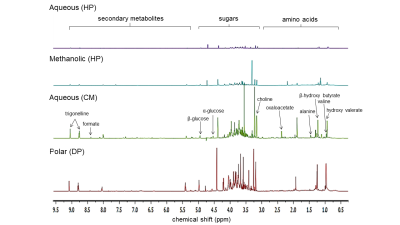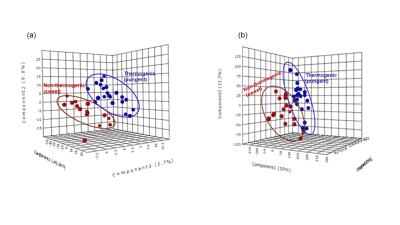2888
Proton NMR metabolomics guided prediction of anti-obesity properties of medicinal plants1Department of NMR, All India Institute of Medical Sciences, New Delhi, India
Synopsis
Given the alarming increase in obesity and associated NCDs, use of nutritional and medicinal plants in obesity management have come into focus. There is growing interest in pungent thermogenic plants with anti-obesity activity. With this in view, the study has explored the potential of NMR metabolomics to identify plants with anti-obesity activity based on their chemosensory and thermogenic properties, the latter evaluated by Differential Scanning Calorimeter. Multivariate analysis of NMR data discriminated thermogenic (pungent) and non-thermogenic (sweet) plants and also correlated well with the calorimetry analyses. NMR can identify quickly plants with anti-obesity potential using their chemosensory associated thermogenic properties.
Abstract
IntroductionObesity has become a serious health issue worldwide. Its association with conditions such as diabetes mellitus, osteoarthritis, hypertension and cancer has compounded the problem further1. In such a worrying health scenario, there is also an increasing awareness of the role and importance of diet and nutrition in general and in particular in management of obesity. This has led to research on plants with nutritional and medicinal properties which can help fight obesity. Interestingly, thermogenic property of plants has been shown to stimulate and increase energy expenditure and hence found useful in treatment of obesity. For example, the pungent principles of Piper nigrum and Capsicum annum have been reported to possess anti-obesity activity2,3. In this study, the potential of NMR metabolomics to identify plants with anti-obesity activities based on their chemosensory properties was explored along with evaluation of their thermogenic activities using Differential Scanning Calorimetry (DSC).
Materials and Methods
Sample preparation: Thirty-eight dietary and medicinal plants from two chemosensory categories were selected for the study: sweet - 17 plants such as Vitis vinifera, Musa paradisiaca and Phoenix sylvestris; pungent - 21 plants such as Piper nigrum, Zingiber officinalis and Capsicum annum. Standardisation of sample preparation was carried out using the following extraction methods: (i) Hot Percolation (HP) using water and methanol separately (ii) Cold Maceration (CM) (iii) Dual Phase (DP) using methanol/water: chloroform. Extracts obtained by HP were dried by heating, CM by lyophilization and polar fraction by DP using rotary vacuum concentrator.
NMR studies: The dried extracts were dissolved in D2O and 1D proton NMR spectra were acquired at 700 MHz (Agilent, USA) using a relaxation delay of 14 sec, 64 scans, spectral width of 12 ppm and 32 K data points. Deuterated TSP in a coaxial insert served as the reference.
Data analysis: NMR spectra were binned and bucketed at intervals of 0.04 ppm (Mnova 10.0, Mestrelab Research) for multivariate analysis (Metaboanalyst 4.0). Partial Least Square Discriminant Analysis (PLS-DA) was carried out and peaks influencing the variability between the groups (p < 0.05) were identified from the loading plots and Variable Importance in Projection (VIP) scores analysis. Peak assignments were carried out using NMR data libraries.4,5
DSC studies: Lyophilized powder (5mg) of CM aqueous extracts of plants were evaluated using differential scanning calorimeter (DSC 60, Shimadzu Scientific Instruments, Japan). Samples were heated between 25⁰ C and 500⁰ C at a rate of 10⁰C⁄min in air atmosphere (flowrate -100 mL⁄min). Exothermic and endothermic reactions are represented as positive and negative curves, respectively on the y-axis.
Results
Figures 1a-1d show representative 1H spectra of Trigonella foenum from the pungent taste group extracted by various methods. The peaks can be broadly classified as primary [amino acids (0.9-3.5 ppm), sugars (3.5-5.5 ppm)] and secondary metabolites (6-9 ppm). CM and DP extracts showed maximum peaks from primary as well as secondary metabolites.Figure 2 shows representative DSC thermograms of plants from sweet (Fig. 2a) and pungent (Fig. 2b) category. Nineteen out of twenty-one plants from pungent category showed exothermic (thermogenic) nature while most of the plants in sweet category showed endothermic (non-thermogenic).
Figure 3 compares PLS-DA of NMR data from plants extracted by CM (Fig. 3a) and DP (Fig. 3b) methods. CM extracted plant samples showed better clustering and discrimination between the two groups compared to those from DP extraction. The PLS-DA model gave significant goodness of fit (R2>0.8) and predictability (Q2>0.4) for CM extracts. The reason for better discrimination by CM method could be extraction of important chemosensory polar phytocompounds. The extraction by DP, on the other hand, would have included some semi-polar phytocompounds as well.
Chemosensory markers for CM extracts were identified from loading and VIP scores (>1): sweet - α glucose, sucrose, fructose and glycine; pungent - isoleucine, cinnamic acid and trigonelline. The thermogenicity of plants evaluated with DSC correlated well with NMR metabolomics-based discrimination between pungent (thermogenic) and sweet (non-thermogenic) group of plants.
Conclusion
Obesity is a rapidly growing threat to global health. Search for novel therapeutics more efficient and safer have led to research on thermogenic properties of nutritional and medicinal plants3. There are reports of association of pungent phytocompounds such as capsaicin to anti-obesity action due to their thermogenic properties. In this context, this study has explored the potential of NMR metabolomics coupled with calorimetric studies to identify plants with anti-obesity activity. The preliminary results have shown that NMR metabolomics in combination with DSC thermograms can discriminate plants which are thermogenic (pungent) from the non-thermogenic (sweet). NMR can be a quick method to identify plants with anti-obesity potential and can also play an important role providing insight into the thermogenic and chemosensory nature of their active principles.
Acknowledgements
The work was supported by National Medicinal Plants Board, Ministry of AYUSH, Government of India.References
1. Engin A. The Definition and Prevalence of Obesity and Metabolic Syndrome. Adv Exp Med Biol. 2017; 960: 1-17.
2. Shah SS, Shah GB, Singh SD, et al. Effect of piperine in the regulation of obesity-induced dyslipidemia in high-fat diet rats. Indian J Pharmacol. 2011; 43: 296-299.
3. Zheng J, Zheng S, Feng Q, et al. Dietary capsaicin and its anti-obesity potency: from mechanism to clinical implications. Biosci Rep. 2017; 37: BSR20170286.
4. Wishart DS, Jewison T, Guo AC, et al. HMDB 3.0 - The Human Metabolome Database in 2013. Nucleic Acids Res. 2013; 41: D801-D807.
5. Deborde C, Jacob D. MeRy-B, a metabolomic database and knowledge base for exploring plant primary metabolism. Methods Mol Biol. 2014; 1083: 3-16.
Figures


